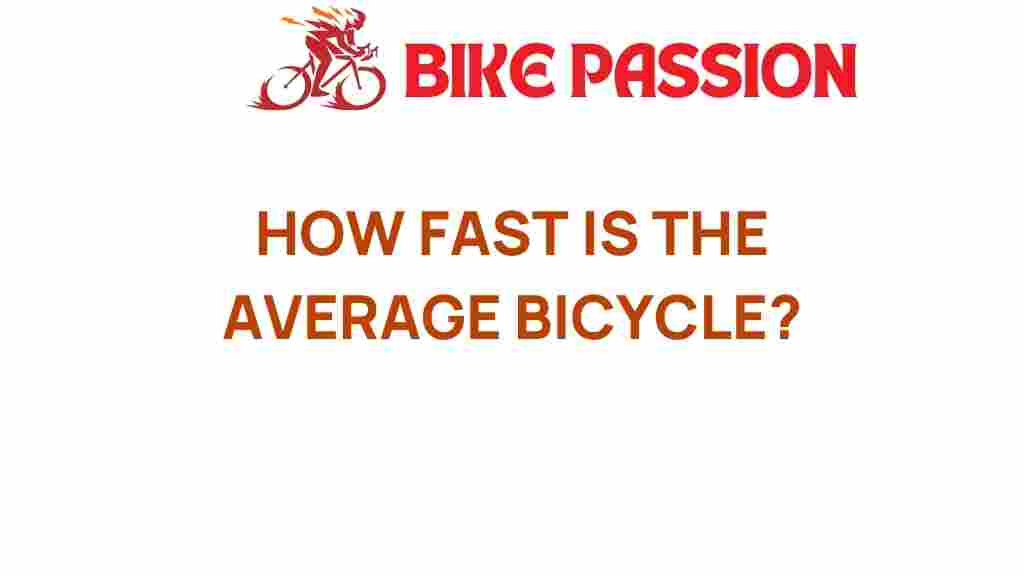Unveiling the Secrets: How Fast Can the Average Bicycle Go?
Bicycling is one of the most popular outdoor activities, combining fitness with enjoyment of nature. Whether you’re commuting or exploring scenic routes, understanding bicycle speed is crucial for optimizing your cycling performance. In this article, we will explore how fast the average bicycle can go, discussing various factors that influence speed, average cycling pace, and tips to enhance your cycling experience.
Understanding Bicycle Speed
Bicycle speed refers to how fast a bicycle can travel over a certain distance. This speed can vary significantly based on several factors including bike technology, rider fitness, terrain, and environmental conditions. The average cycling pace for recreational cyclists generally ranges from 12 to 16 miles per hour (mph), while more experienced riders can average between 16 and 24 mph.
Factors Influencing Average Cycling Pace
Several key factors affect how fast a bicycle can go. Understanding these can help cyclists improve their performance:
- Rider Fitness: A cyclist’s physical condition plays a significant role in determining their average speed. Better fitness levels lead to increased endurance and speed.
- Bike Technology: Modern bicycles come equipped with advanced technology, including lightweight frames, aerodynamic designs, and efficient gearing systems, which can greatly enhance speed.
- Terrain: The type of terrain significantly affects cycling performance. Flat, smooth roads allow for faster speeds compared to hilly or rough terrains.
- Weather Conditions: Wind resistance can slow a cyclist down. Riding against a strong headwind can decrease average cycling pace, while a tailwind can help increase speed.
- Cycling Technique: Efficient pedaling, proper body positioning, and effective gear shifting can improve speed significantly.
Average Bicycle Speeds Across Different Types of Cyclists
To provide a clearer picture of bicycle speeds, let’s break down average speeds by different categories of cyclists:
- Casual Riders: These cyclists typically ride for leisure and fitness. Their average speed generally ranges from 10 to 14 mph.
- Commuters: Cyclists using bikes for commuting usually have an average speed of about 12 to 16 mph, depending on traffic and road conditions.
- Enthusiasts: More serious cyclists, often riding in groups or training, average between 16 to 20 mph.
- Competitive Cyclists: Professional racers can achieve average speeds exceeding 25 mph during races, especially on flat courses.
How to Measure Your Bicycle Speed
Measuring your bicycle speed can be done easily with various tools. Here are some popular methods:
- Bike Computers: These devices attach to your bike and provide real-time data on speed, distance, and time.
- Smartphone Apps: Many cycling apps use GPS to track speed and can offer additional features like route mapping and performance tracking.
- GPS Devices: Handheld GPS devices are another option for tracking your cycling performance.
Improving Your Cycling Performance
To maximize your bicycle speed and overall cycling performance, consider implementing the following tips:
- Regular Training: Incorporating interval training and long rides into your routine can help build endurance and speed.
- Strength Training: Focus on exercises that enhance leg strength and core stability, which are essential for effective cycling.
- Proper Nutrition: Fuel your body with a balanced diet rich in carbohydrates, protein, and healthy fats to support your cycling efforts.
- Bike Maintenance: Regularly check your bike for proper tire pressure, chain lubrication, and brake function to ensure optimal performance.
- Learn Cycling Techniques: Work on improving your pedaling technique, gearing skills, and riding posture.
Cycling Tips for Different Conditions
Adapting your cycling approach based on conditions can enhance your cycling experience. Here are some tips:
Riding in Windy Conditions
When cycling in windy weather, consider these tips:
- Position your body to minimize wind resistance, such as lowering your torso.
- Draft behind other cyclists if riding in a group to reduce wind impact.
- Use lower gears to maintain a steady pace against headwinds.
Cycling Uphill
Hills can be challenging, but the following strategies can help:
- Shift to a lower gear to make pedaling easier.
- Maintain a steady cadence rather than trying to push too hard.
- Focus on your breathing to stay calm and efficient.
Cycling on Flat Terrain
To maximize your speed on flat roads:
- Maintain an aerodynamic position to reduce drag.
- Use a higher gear to increase speed while pedaling efficiently.
- Engage in group rides to benefit from drafting.
Common Cycling Troubleshooting Tips
Even experienced cyclists encounter issues on the road. Here are some troubleshooting tips:
- Flat Tires: Always carry a spare tube and know how to change a tire.
- Chain Issues: If your chain slips or makes noise, clean and lubricate it regularly.
- Brakes Not Responding: Check the brake pads and cables to ensure they are functioning correctly.
The Role of Bike Technology in Enhancing Speed
Advancements in bike technology have significantly impacted cycling performance. Here are some innovations that contribute to bicycle speed:
- Aerodynamic Frames: Many modern bikes are designed with aerodynamic shapes to reduce wind resistance.
- Lightweight Materials: Materials such as carbon fiber and aluminum make bikes lighter and easier to accelerate.
- Advanced Gearing Systems: Electronic shifting systems offer precise gear changes, allowing cyclists to maintain optimal cadence.
For more information on the latest in bike technology, check out this informative resource.
Conclusion: The Joy of Cycling and Speed
Understanding bicycle speed and the factors that influence average cycling pace can enhance your cycling experience and performance. By focusing on fitness, mastering cycling techniques, and leveraging bike technology, you can improve your speed and enjoy the many benefits of this wonderful outdoor activity.
Remember, cycling is not just about speed; it’s about enjoying the ride and the journey. So, get out there, stay active, and pedal your way to fitness!
For more cycling tips and performance enhancement strategies, feel free to explore our detailed guide on cycling fitness.
This article is in the category Gear and created by BikePassion Team
